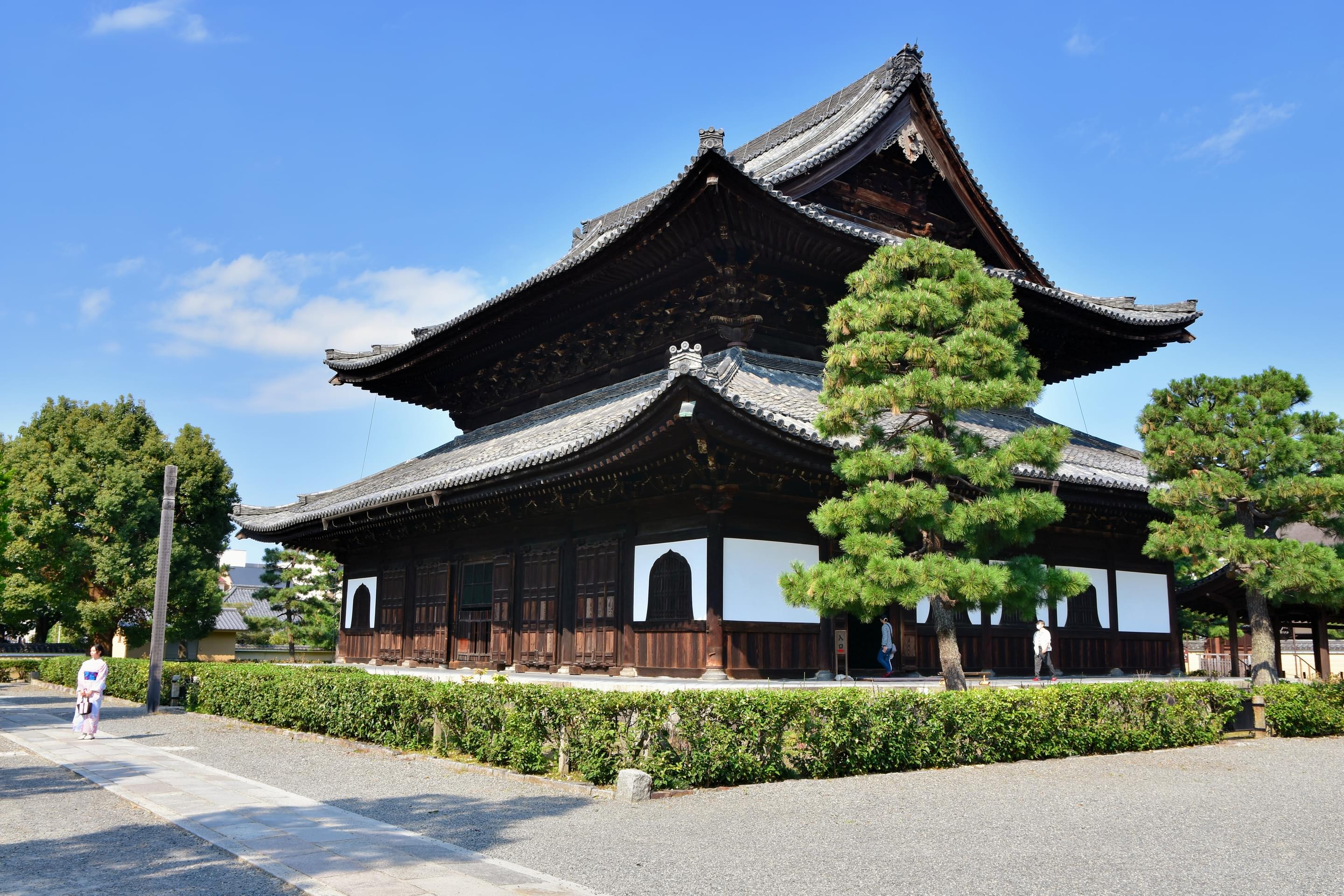Kenninji Temple in Kyoto is located near the famous Shijo and Hanamikoji streets. This Zen place was founded by the Buddhist monk Yosai (Eisai) who introduced Japan to tea cultivation and Zen Buddhism. It is the oldest Zen temple in Kyoto and was constructed in 1202. This large complex has multiple gates and halls with around 12 small buildings surrounding them.
Step inside and admire the ceilings enveloped in ink paintings of giant dragons and interior gardens. You will also find stunning painted screens of thunder and wind gods around you. Take a walk around the Chō’ontei Garden, a Zen Garden which is located behind the main building.
This is also known as the Garden of the Sound of the Tide and was constructed using three Sanzo seki. You will also see some beautiful Camellia Sinensis bushes around the gardens. They emphasise the importance of tea drinking in Japan and its connection to the temple.
Highlights
• Admire the Zen Gardens and intricate cultural artwork adorning the building of the Kenninji Temple and conveying the tales of Japanese heritage.
• Visit the main hall, Hattou Building which displays a beautiful pent roof and statues of Japanese priests with screen-door paintings of thunder and wind gods.
• Stroll through the peaceful Choutei Garden to soak in the mossy yet soothing ambience and sit underneath the maple trees for meditation at San-zon-seki.
• Participate in the tea jar procession at the temple during May which depicts a strong connection between Japan’s tea-drinking origins and a Zen philosophy.
• Bask in the purity of the dry landscape garden which depicts the conceptualisation of the universe and the circle, triangle, and square paintings of monk Sengai.
How To Reach
- By Car: Kenninji Temple is 2.3 km from the Kyoto City Centre and takes approximately 10 minutes.
- By Bus: Take the #206 bus to the Higashiyama Yasui or Gion Bus Stop. These bus stops are approximately 10 minutes walking distance from the temple.
- By Train: Take the Keihan Line Train to Gion Shijō Station or the Hankyū Line Train to Kyoto Kawaramachi Station. Both the drop points are 10 minutes from the temple.
Best Time To Visit
Kenninji Temple is open to the public throughout the year.
- Best Season: Visit Kenninji Temple between March and April as the surroundings are enveloped with cherry blossoms during these months.
- Best Day in the Week: Visit on weekdays as the crowd is comparatively less and gives you an immersive experience.
- Best Time of the Day: Visit early morning to ditch the crowd and stroll through the halls and gardens freely.
Other Essential Information
- Wear comfortable attire to maintain the sanctity of the temple and use shoes as you might have to walk for quite some time.
- Maintain a respectful silence and keep your voice low to preserve the calm atmosphere inside the halls.
- Follow the paths laid out for you and refrain from stepping on tatami mats inside the temple.
- If you visit during the tea ceremony and celebrations, participate in them to understand the Japanese Zen culture.
- Visit early morning or late in the afternoon to avoid crowds and get the best experience.
- Respect the processions and ceremonies and let the practitioners worship without any disturbance.
Look at the Twin Dragon painting at Dharma Hall, Hatto
This hall is one of the main structures within the building. The moment you step inside, you will find a twin dragon painting on the ceiling which was created by the famous artist Koizumi Junsaku. It symbolises the protection and power of the temple. You will also find various paintings of Raijin (God of Thunder) and Fujin (God of Wind) on the folding screens around. They were crafted by Tawaraya Sōtatsu and serve as the prime examples of Japanese art.
Explore the Tea Houses
Kenninji Temple has a strong connection with the tea-drinking habit of Japan and Zen Buddhism. There are tea houses occupied for the upcoming tea ceremonies. You can observe from afar or be a part of the ceremony to get insight into the preparation ritual. These houses also give you an insight into the meditation of the ancient Japanese tradition.

